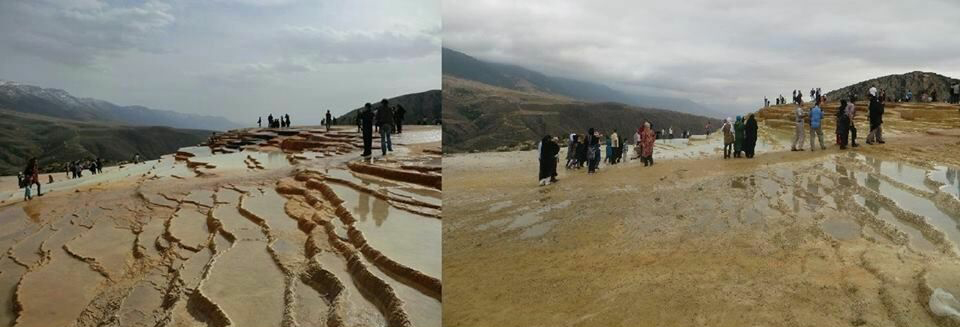Badab-e-Soort Natural Springs in Mazandaran Province is once again open to the public after the site was declared closed last September due to severe damage inflicted on the area.
However, the ban may have been lifted too early, as locals say the site is far from restored, according to a report by ISNA.
The natural site comprises a range of stepped travertine terrace formations created over thousands of years as flowing water from two mineral hot springs cooled and deposited carbonate minerals on the mountainside.
However, carelessness on the part of officials and tourists has caused considerable damage to the site and the environment, flattening the stepped terraces and polluting what little water still flows from the springs, forcing authorities in the provincial capital Sari to ban all visits to Badab-e-Soort in the fall.
Quoting residents of Oroust Village, where the site is located, the news agency reported that despite banning visitors from the site, tour operators never stopped organizing trips to the site. The ban was essentially ignored by tourists and never enforced by officials.
The ban was in place to allow authorities to fence the area off, place guards around the springs, restore the flattened terraces and build new roads that would help prevent visitors from stamping all over the delicate site.
Nevertheless, Mehran Hassani, tourism deputy at the provincial office of Iran’s Cultural Heritage, Handicrafts and Tourism Organization, decided to officially open the site to tourists prior to the Norouz holiday (March 20 – April 1), apparently content with the site’s restoration.
The move was defended by the director of the provincial ICHHTO office, Delavar Bozorgnia, who said his office “is now managing the flow of tourists in and out of the site” and that “there are no unregulated, unscheduled tours anymore.”
This is while the locals claim that despite the ban more than seven months ago, the village was swarmed by hundreds of coaches carrying tourists to the natural site on a weekly basis.
Responsible Tourism Ignored
Shortly after the ban supposedly went into effect, a group of environmentalists initiated a campaign to help restoration efforts. They helped collect the trash tourists had left behind and installed a big board at the entrance of Badab-e-Soort that included information about the site and the need for responsible tourism.
The board is now damaged and the posts on which it was installed on severely bent.
“We had a small budget and spent over half of it on the board,” said Ali Shadlou, who started the campaign. “Nobody knows what happened to it.”
He said when his group went to Badab-e-Soort to help clean up the site, they encountered tour groups waiting for his team to leave before entering the site, despite the ban still being in place.
“I actually heard one of the tour guides tell his group to be patient until we leave so they can roam around the area in peace,” an incredulous Shadlou recalled.
Inscribed in 2008 on the National Heritage List, Badab-e-Soort is only one of two natural sites to make it on the list, with the other being Mount Damavand, also in Mazandaran Province.
Despite the area being one of Iran’s most visited natural sites, officials failed to fence off the area and place guards to ensure tourists would not venture too far into the fragile heritage site.
Furthermore, protecting and preserving heritages are not acculturated in Iran, making incidents like this far too common an occurrence to be disregarded as an accident.
Activists had warned cultural heritage officials about the potential fallout of unregulated tours to the area, but as usual their warnings fell on deaf ears.


